Abstract
Gastric inhibitory polypeptide (GIP) is considered to be the principal mediator of the enteroinsular axis. A glucose-insulin clamp technique was used to study the effects of differing blood glucose levels on the insulinotropic and glucagonotropic actions of fat-stimulated GIP in seven healthy subjects, as well as the effect of physiologic hyperinsulinemia on GIP secretion. Blood glucose levels were clamped for 4 h at 43±2 mg/dl (hypoglycemic clamp), 88±1 mg/dl (euglycemic clamp), and 141±2 mg/dl (hyperglycemic clamp) in the presence of a constant insulin infusion (100 m U/kg per h).
Under hypoglycemic clamp conditions there was no increase in C-peptide nor glucagon after Lipomul ingestion, despite an increase of GIP of 51.7±8.7 ng/ml per 120 min. Under euglycemic clamp conditions, small and inconsistent increases in C-peptide and glucagon were observed after fat ingestion and a concomitant increase of GIP of 35.2±9.4 ng/ml per 120 min. Under hyperglycemic clamp conditions after fat ingestion and a GIP increase of 24.0±5.7 ng/ml per 120 min, C-peptide increased from 6.4±5 ng/ml to 11.0±1.1 ng/ml (P < 0.01) but glucagon did not change. These findings confirm that in healthy man GIP exerts its insulinotropic properties only under hyperglycemic conditions and indicate that GIP is not glucagonotropic.
Under euglycemic clamp conditions (plasma glucose, 89±1 mg/dl) and physiologic hyperinsulinemia (serum immunoreactive insulin, 137±3 μU/ml) GIP responses to fat ingestion (39.7±9.8 ng/ml per 120 min) were not different from the GIP responses to fat ingestion in the absence of hyperinsulinemia (39.7±11.1 ng/ml per 120 min). Therefore, insulin under normoglycemic conditions does not exert an inhibitory effect on fat-stimulated GIP secretion. The higher GIP response to oral fat in the hypoglycemic clamp, and the lower GIP response in the hyperglycemic clamp compared to the response in the euglycemic clamp suggests an effect of glycemia itself on GIP secretion in the presence of hyperinsulinemia.
Full text
PDF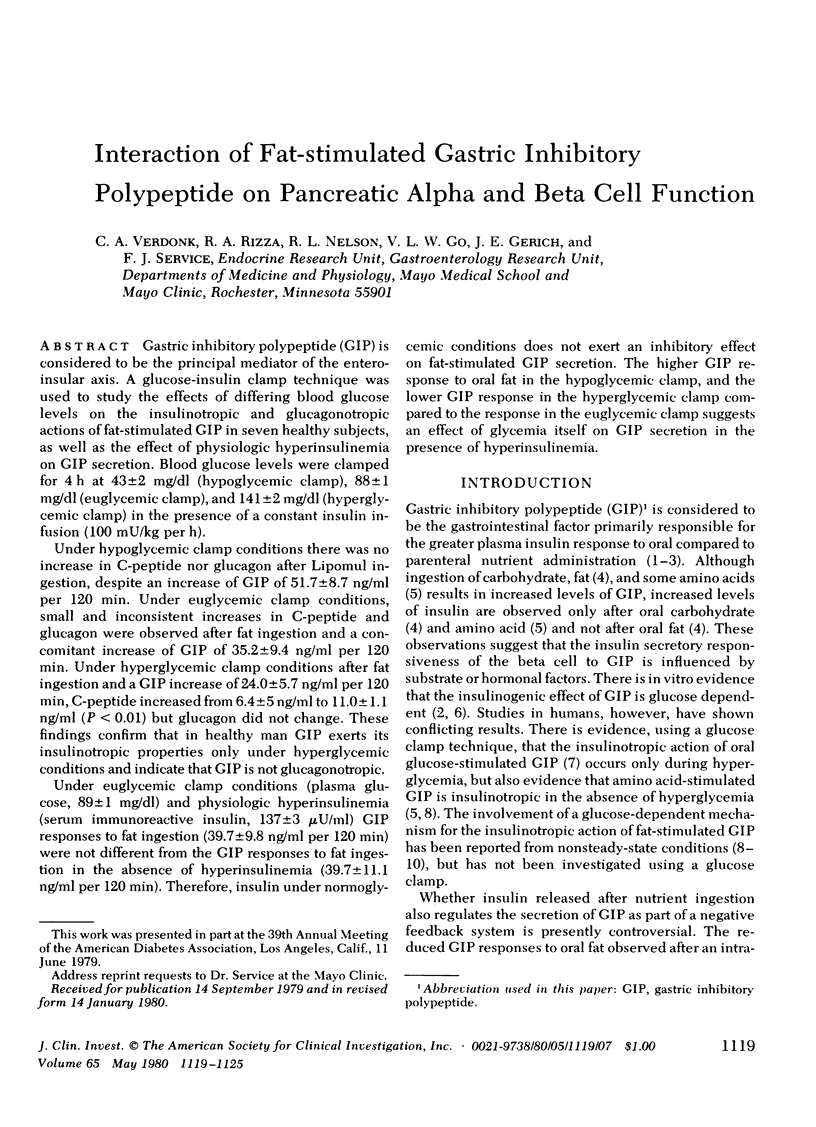
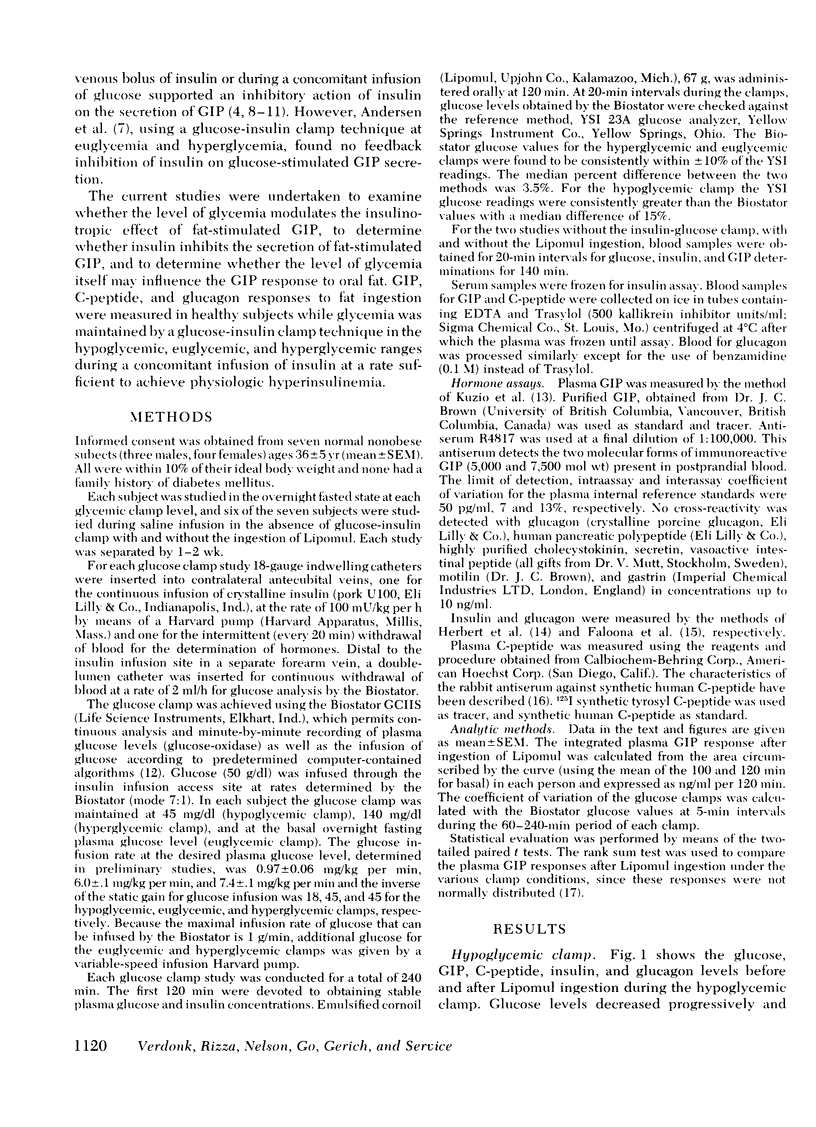
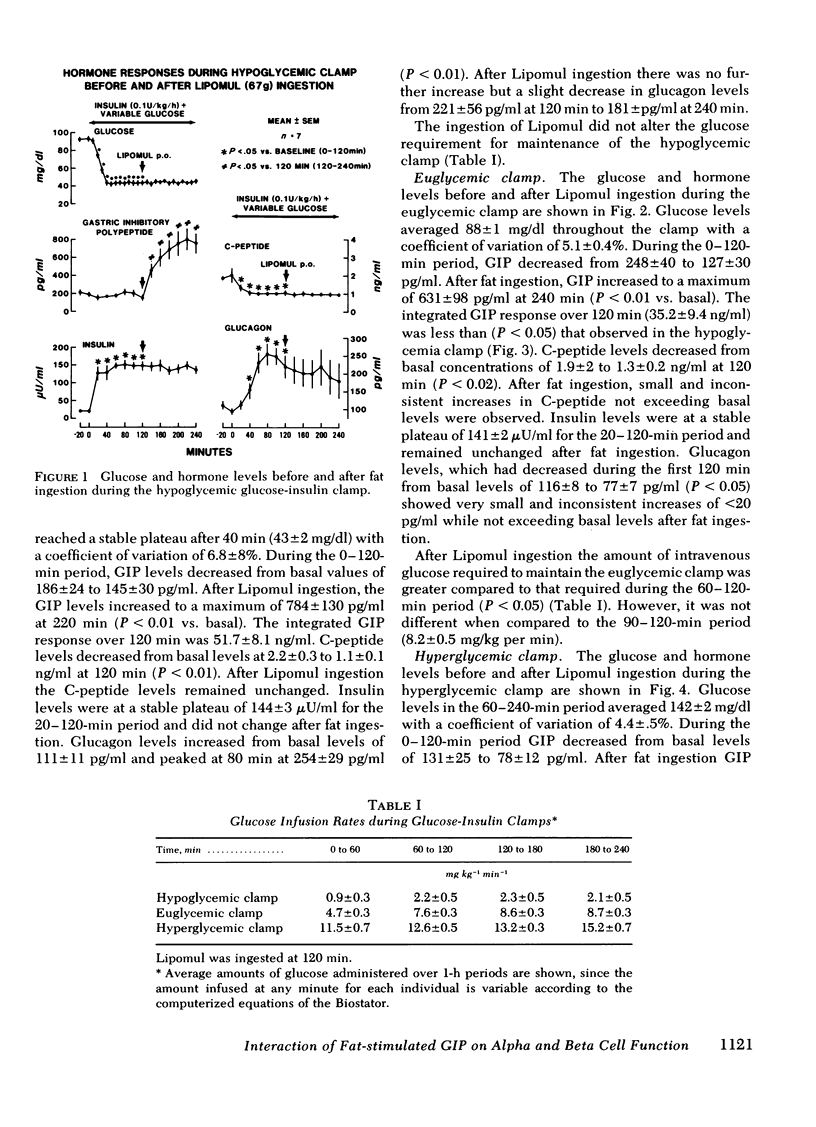
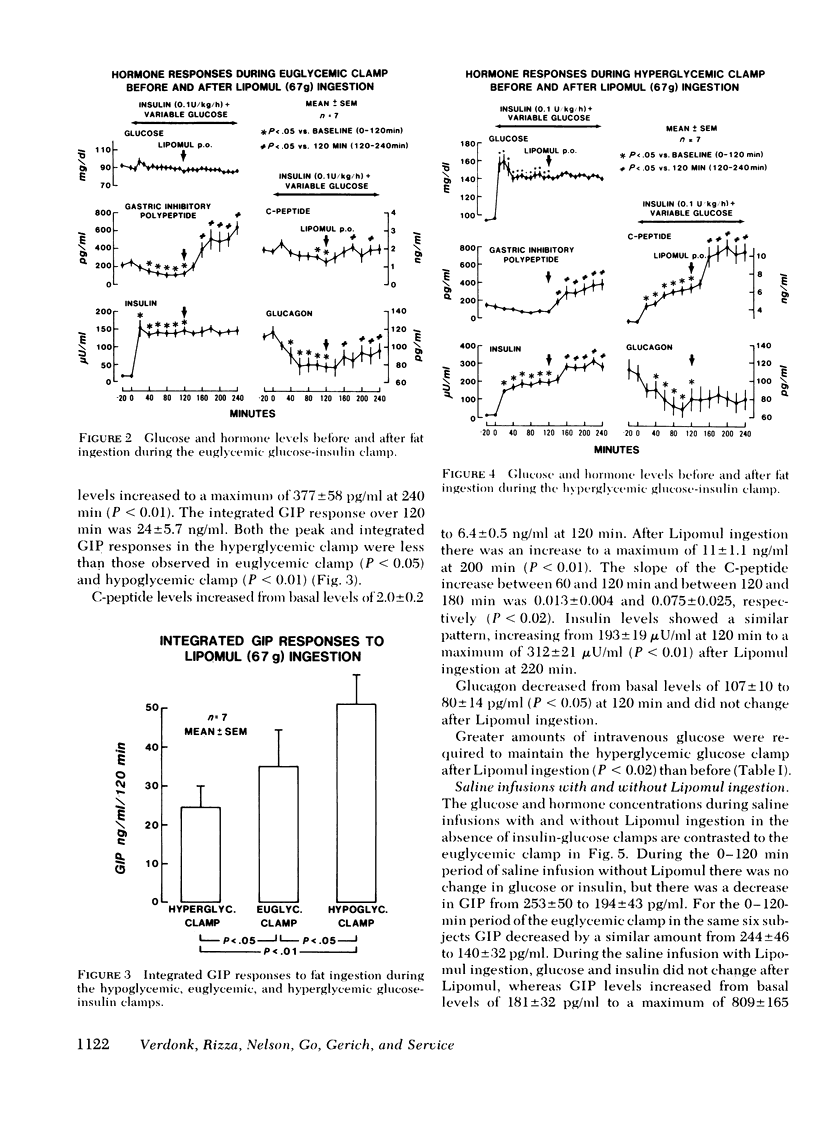
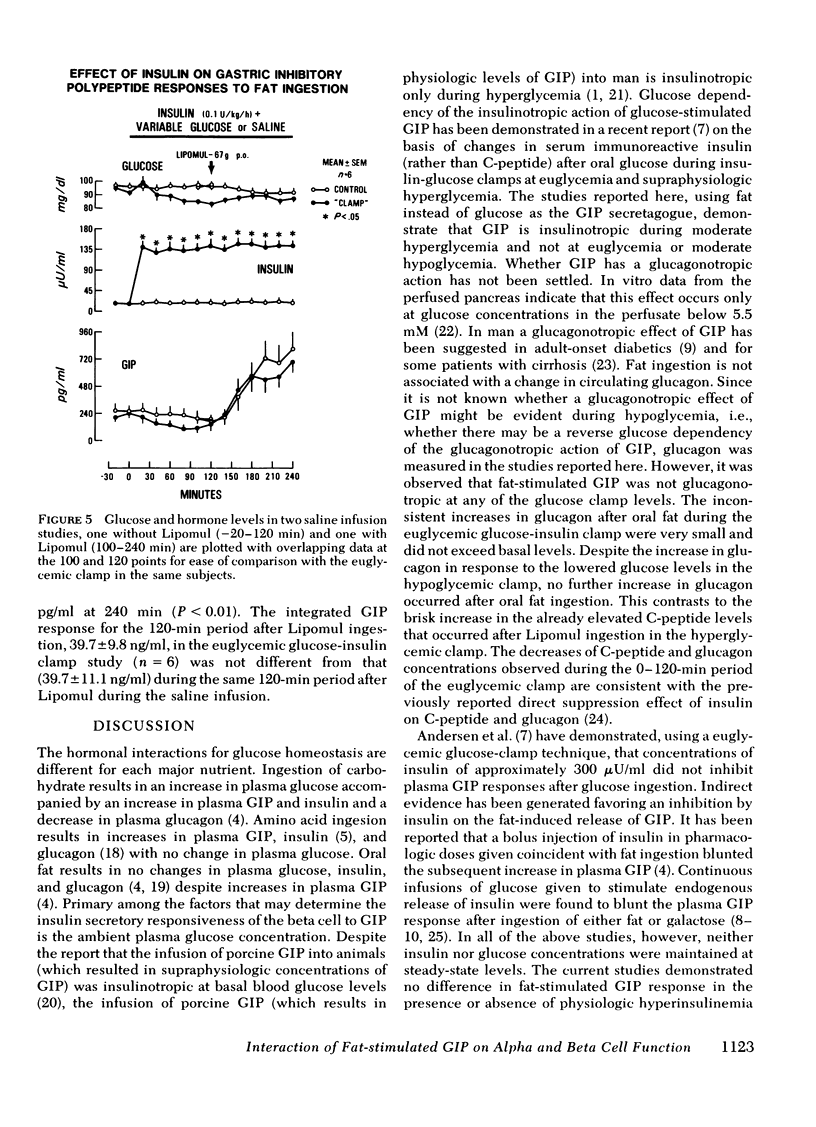
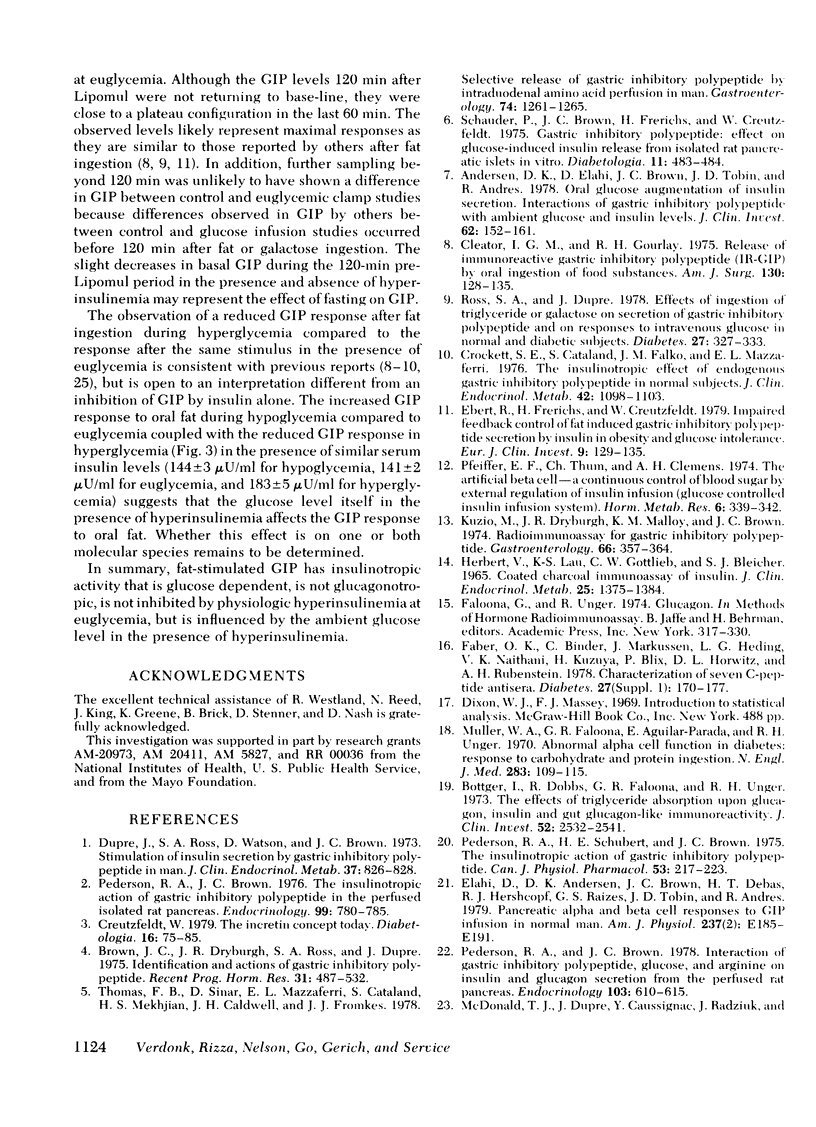
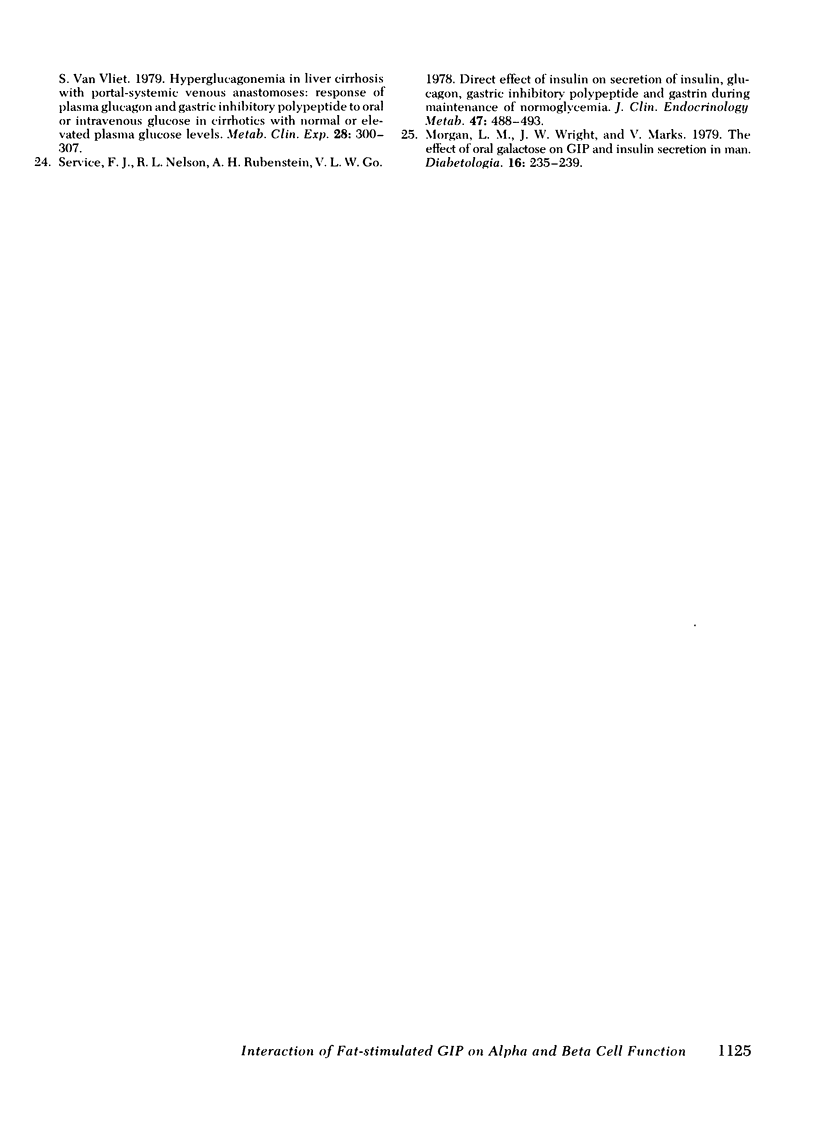
Selected References
These references are in PubMed. This may not be the complete list of references from this article.
- Andersen D. K., Elahi D., Brown J. C., Tobin J. D., Andres R. Oral glucose augmentation of insulin secretion. Interactions of gastric inhibitory polypeptide with ambient glucose and insulin levels. J Clin Invest. 1978 Jul;62(1):152–161. doi: 10.1172/JCI109100. [DOI] [PMC free article] [PubMed] [Google Scholar]
- Brown J. C., Dryburgh J. R., Ross S. A., Dupré J. Identification and actions of gastric inhibitory polypeptide. Recent Prog Horm Res. 1975;31:487–532. doi: 10.1016/b978-0-12-571131-9.50017-7. [DOI] [PubMed] [Google Scholar]
- Böttger I., Dobbs R., Faloona G. R., Unger R. H. The effects of triglyceride absorption upon glucagon, insulin, and gut glucagon-like immunoreactivity. J Clin Invest. 1973 Oct;52(10):2532–2541. doi: 10.1172/JCI107444. [DOI] [PMC free article] [PubMed] [Google Scholar]
- Cleator I. G., Gourlay R. H. Release of immunoreactive gastric inhibitory polypeptide (IR-GIP) by oral ingestion of food substances. Am J Surg. 1975 Aug;130(2):128–135. doi: 10.1016/0002-9610(75)90360-8. [DOI] [PubMed] [Google Scholar]
- Creutzfeldt W. The incretin concept today. Diabetologia. 1979 Feb;16(2):75–85. doi: 10.1007/BF01225454. [DOI] [PubMed] [Google Scholar]
- Dupre J., Ross S. A., Watson D., Brown J. C. Stimulation of insulin secretion by gastric inhibitory polypeptide in man. J Clin Endocrinol Metab. 1973 Nov;37(5):826–828. doi: 10.1210/jcem-37-5-826. [DOI] [PubMed] [Google Scholar]
- Elahi D., Andersen D. K., Brown J. C., Debas H. T., Hershcopf R. J., Raizes G. S., Tobin J. D., Andres R. Pancreatic alpha- and beta-cell responses to GIP infusion in normal man. Am J Physiol. 1979 Aug;237(2):E185–E191. doi: 10.1152/ajpendo.1979.237.2.E185. [DOI] [PubMed] [Google Scholar]
- Herbert V., Lau K. S., Gottlieb C. W., Bleicher S. J. Coated charcoal immunoassay of insulin. J Clin Endocrinol Metab. 1965 Oct;25(10):1375–1384. doi: 10.1210/jcem-25-10-1375. [DOI] [PubMed] [Google Scholar]
- Kuzio M., Dryburgh J. R., Malloy K. M., Brown J. C. Radioimmunoassay for gastric inhibitory polypeptide. Gastroenterology. 1974 Mar;66(3):357–364. [PubMed] [Google Scholar]
- McDonald T. J., Dupre J., Caussignac Y., Radziuk J., Van Vliet S. Hyperglucagonemia in liver cirrhosis with portal-systemic venous anastomoses: responses of plasma glucagon and gastric inhibitory polypeptide to oral or intravenous glucose in cirrhotics with normal or elevated fasting plasma glucose levels. Metabolism. 1979 Apr;28(4):300–307. doi: 10.1016/0026-0495(79)90099-4. [DOI] [PubMed] [Google Scholar]
- Morgan L. M., Wright J. W., Marks V. The effect of oral galactose on GIP and insulin secretion in man. Diabetologia. 1979 Apr;16(4):235–239. doi: 10.1007/BF01221949. [DOI] [PubMed] [Google Scholar]
- Müller W. A., Faloona G. R., Aguilar-Parada E., Unger R. H. Abnormal alpha-cell function in diabetes. Response to carbohydrate and protein ingestion. N Engl J Med. 1970 Jul 16;283(3):109–115. doi: 10.1056/NEJM197007162830301. [DOI] [PubMed] [Google Scholar]
- Pederson R. A., Brown J. C. Interaction of gastric inhibitory polypeptide, glucose, and arginine on insulin and glucagon secretion from the perfused rat pancreas. Endocrinology. 1978 Aug;103(2):610–615. doi: 10.1210/endo-103-2-610. [DOI] [PubMed] [Google Scholar]
- Pederson R. A., Brown J. C. The insulinotropic action of gastric inhibitory polypeptide in the perfused isolated rat pancreas. Endocrinology. 1976 Sep;99(3):780–785. doi: 10.1210/endo-99-3-780. [DOI] [PubMed] [Google Scholar]
- Pederson R. A., Schubert H. E., Brown J. C. The insulinotropic action of gastric inhibitory polypeptide. Can J Physiol Pharmacol. 1975 Apr;53(2):217–223. doi: 10.1139/y75-032. [DOI] [PubMed] [Google Scholar]
- Ross S. A., Dupre J. Effects of ingestion of triglyceride or galactose on secretion of gastric inhibitory polypeptide and on responses to intravenous glucose in normal and diabetic subjects. Diabetes. 1978 Mar;27(3):327–333. doi: 10.2337/diab.27.3.327. [DOI] [PubMed] [Google Scholar]
- Schauder P., Brown J. C., Frerichs H., Creutzfeldt W. Gastric inhibitory polypeptide: effect on glucose-induced insulin release from isolated rat pancreatic islets in vitro. Diabetologia. 1975 Oct;11(5):483–484. doi: 10.1007/BF00429919. [DOI] [PubMed] [Google Scholar]
- Service F. J., Nelson R. L., Rubenstein A. H., Go V. L. Direct effect of insulin on secretion of insulin, glucagon, gastric inhibitory polypeptide, and gastrin during maintenance of normoglycemia. J Clin Endocrinol Metab. 1978 Sep;47(3):488–493. doi: 10.1210/jcem-47-3-488. [DOI] [PubMed] [Google Scholar]
- Thomas F. B., Sinar D., Mazzaferri E. L., Cataland S., Mekhjian H. S., Caldwell J. H., Fromkes J. J. Selective release of gastric inhibitory polypeptide by intraduodenal amino acid perfusion in man. Gastroenterology. 1978 Jun;74(6):1261–1265. [PubMed] [Google Scholar]


